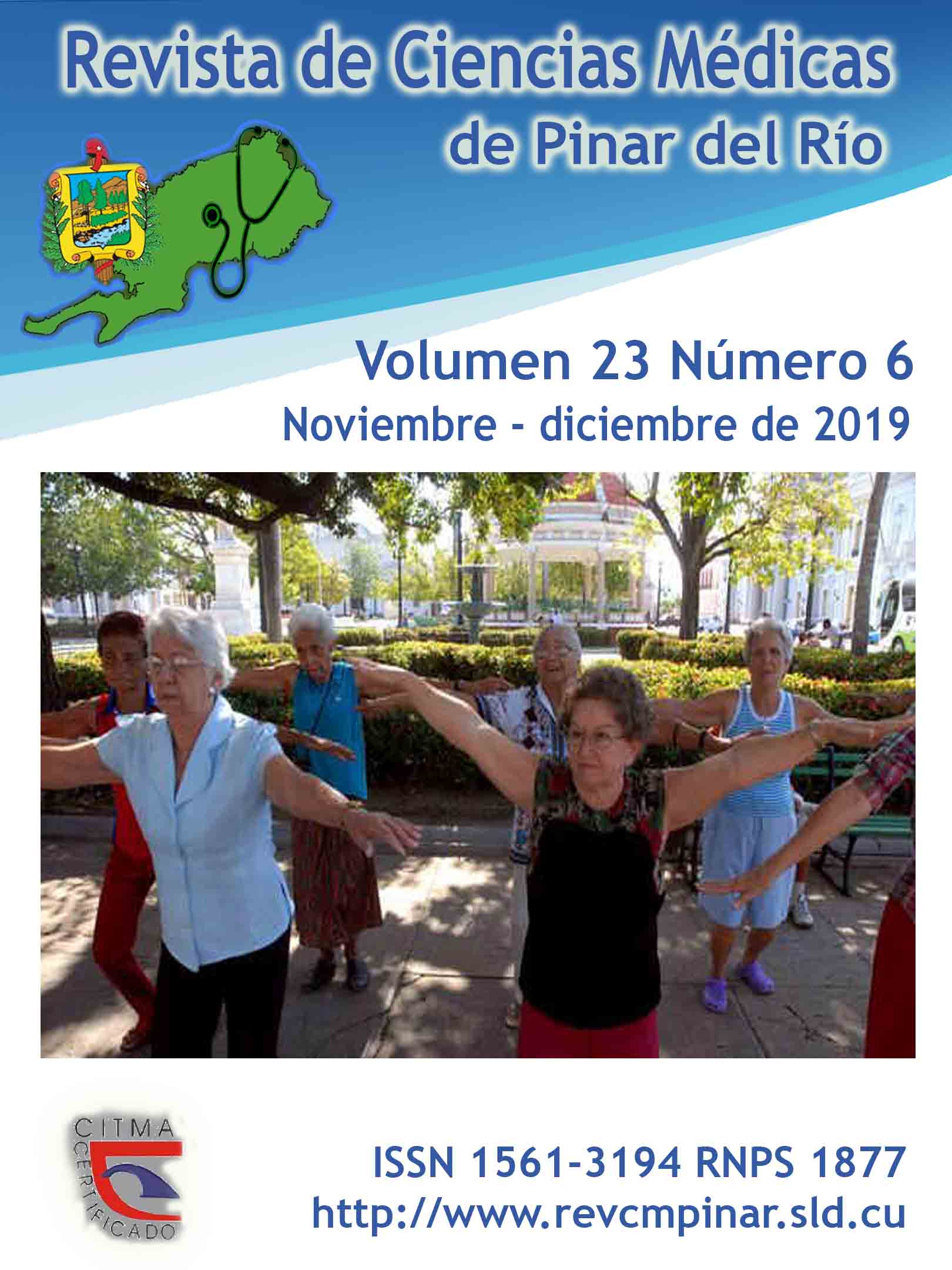The teaching staff of the subject Dental Rehabilitation in the implementation of written evaluative instruments
Keywords:
EVALUATION, EDUCATIONAL MEASUREMENT, TEACHING, LEARNING, STUDENTS.Abstract
Introduction: evaluation instruments allow students to assess changes or results produced as a consequence of the teaching-learning process, which is controlled and evaluated by the teaching staff of the subject.
Objective: to identify the design and difficulties of examinations applied by the teaching staff of the subject Dental Rehabilitation I and II in the period 2013 and 2017.
Methods: a cross-sectional, descriptive, retrospective study was carried out, reviewing 42 designs of exams that were applied at the end of each rotation of the subjects, in the period between 2013-2017, in order to determine the type of questions established and those having the greatest complexities to the students.
Development: the types of questions most used were those of restricted answers (complete) with 89,6 %, followed by multiple-choice tests in their variant, false and true (85,8 %). The former was the most complex in the answers (30,3 %).
Conclusions: design and main difficulties were identified in the exams applied by the teaching staff of the subject Dental Rehabilitation I and II, recommending to the teaching staff of this subject the application of other types of questions in order to modify the most complex to the students, in future studies.
Downloads
References
1. Hernández Álvarez YC, Massip Acosta A. El colectivo de año en la construcción de poder para la formación de sujetos. Revista Universidad y Sociedad Rev. [Internet]. 2017 [Citado 01/03/2018]; 9(3): [aprox. 69p.] Disponible en: http://scielo.sld.cu/scielo.php?script=sci_arttext&pid=S2218-36202017000300028&lng=es&tlng=pt
2. Chávez Rodríguez JA. Del ideario pedagógico de José de la Luz y Caballero. La Habana: Editorial Pueblo y Educación; 1992. p. 159.
3. Corona Martínez L, Fonseca Hernández M, Quintero Méndez Y, Hernández Abreu C, Fresneda Quintana O. Cuestionarios diferentes en la evaluación escrita. A propósito de los resultados en un trabajo de control parcial de Medicina Interna. Medisur [Internet]. 2017 Oct [Citado 07/12/2018]; 15(5): [aprox. 10p.]. Disponible en: http://scielo.sld.cu/scielo.php?script=sci_arttext&pid=S1727-897X2017000500011&lng=es
4. Salas Perea RS, Salas Mainegra A. Evaluación para el aprendizaje en ciencias de la salud. EDUMECENTRO [Internet]. 2017 [Citado 07/12/2018]; 9(1): [aprox. 19p.]. Disponible en: http://scielo.sld.cu/scielo.php?script=sci_arttext&pid=S2077-28742017000100013
5. Roméu Escobar MR, Díaz Quiñones JA. Valoración metodológica de la confección de temarios de exámenes finales de Medicina y Estomatología. Educ Med Super [Internet]. 2015 [Citado 07/12/2018]; 29(3). Disponible en: http://scielo.sld.cu/scielo.php?script=sci_arttext&pid=S0864-21412015000300011&lng=es
6. Chaviano Herrera O, Baldomir Mesa T, Coca Meneses O, Gutiérrez Maydata A. La evaluación del aprendizaje: nuevas tendencias y retos para el profesor. EDUMECENTRO [Internet]. 2016 Dic [Citado 07/12/2018]; 8(4): [aprox. 12p.]. Disponible en: http://scielo.sld.cu/scielo.php?script=sci_arttext&pid=S2077-28742016000700014&lng=es
7. Gutiérrez Martorell ST, López Cruz EE, Legañoa Alonso J, Marrero Fente A. Caracterización del examen estatal escrito de Estomatología de la Universidad Médica de Camagüey. Rev Hum Med [Internet]. 2013 Dic [Citado 07/12/2018]; 13(3): [aprox. 22p.]. Disponible en: http://scielo.sld.cu/scielo.php?script=sci_arttext&pid=S1727-81202013000300016&lng=es
8. Trujillo Saínz ZC, Guerra Pando JA, Henríquez Trujillo D. Percepción de profesores y directivos de morfofisiología sobre esencialidades de la confección de instrumentos evaluativos finales. Rev Ciencias Médicas [Internet]. 2013 Ago [Citado: 07/12/2018]; 17(4): [aprox. 6p.]. Disponible en: http://scielo.sld.cu/scielo.php?script=sci_arttext&pid=S1561-31942013000400016&lng=es
9. Romeu Escobar M, Díaz Quiñones J. Valoración metodológica de temarios de exámenes finales de las carreras de Medicina, Estomatología y Enfermería. Medisur [Internet]. 2015 Ago [citado 07/12/2018]; 13(4): [aprox. 4p.]. Disponible en: http://scielo.sld.cu/scielo.php?script=sci_arttext&pid=S1727-897X2015000400009&lng=es
10. Artiles Duarte L, Jaime Valdés LM, Pérez Rodríguez T. Estrategia para mejorar los resultados del examen teórico estatal de la carrera de Medicina. EDUMECENTRO [Internet]. 2017 [Citado: 06/05/2018]; 9(4): [aprox. 8p.]. Disponible en: http://www.revedumecentro.sld.cu/index.php/edumc/article/view/951
11. Triana Hernández B, Romero Recasens J, Pérez González O, García Ramírez M. Gestión de los colectivos de años académicos en la educación superior cubana: tendencias históricas. Revista Academia y Virtualidad [Internet]. 2016 [Citado 07/12/2018]; 9(1): [aprox. 10p.]. Disponible en: https://dialnet.unirioja.es/servlet/articulo?codigo=5342706
12. Ríos Rodríguez M, Martínez Pérez R, Roque Marrero Y, García Cárdenas O. Propuesta de sistema de trabajo metodológico para la formación técnico profesional en Enfermería. Medimay [Internet]. 2015 [Citado 07/12/2018]; 21(s/n): [Aprox. 18p.]. Disponible en: http://www.revcmhabana.sld.cu/index.php/rcmh/article/view/752
13. Sánchez Sanhueza GA, Cisterna Cabrera F. La evaluación de los aprendizajes orientada al desarrollo de competencias en Odontología. Educ Med Super [Internet]. 2014 Mar [Citado 07/12/2018]; 28(1): [aprox. 10p.]. Disponible en: http://scielo.sld.cu/scielo.php?script=sci_arttext&pid=S0864-21412014000100012&lng=es
14. López Espinosa GJ, Quintana Mugica R, Rodríguez Cruz O, Gómez López L, Pérez de Armas A, Aparicio Manresa G. El profesor principal y su preparación para diseñar instrumentos de evaluación escritos. EDUMECENTRO [Internet]. 2014 Ago [Citado: 07/12/2018]; 6(2): [aprox. 15p.]. Disponible en: http://scielo.sld.cu/scielo.php?script=sci_arttext&pid=S2077-28742014000200007&lng=es
Published
How to Cite
Issue
Section
License
Authors who have publications with this journal agree to the following terms: Authors will retain their copyrights and grant the journal the right of first publication of their work, which will be publication of their work, which will be simultaneously subject to the Creative Commons Attribution License (CC-BY-NC 4.0) that allows third parties to share the work as long as its author and first publication in this journal are indicated.
Authors may adopt other non-exclusive license agreements for distribution of the published version of the work (e.g.: deposit it in an institutional telematic archive or publish it in a volume). Likewise, and according to the recommendations of the Medical Sciences Editorial (ECIMED), authors must declare in each article their contribution according to the CRediT taxonomy (contributor roles). This taxonomy includes 14 roles, which can be used to represent the tasks typically performed by contributors in scientific academic production. It should be consulted in monograph) whenever initial publication in this journal is indicated. Authors are allowed and encouraged to disseminate their work through the Internet (e.g., in institutional telematic archives or on their web page) before and during the submission process, which may produce interesting exchanges and increase citations of the published work. (See The effect of open access). https://casrai.org/credit/



